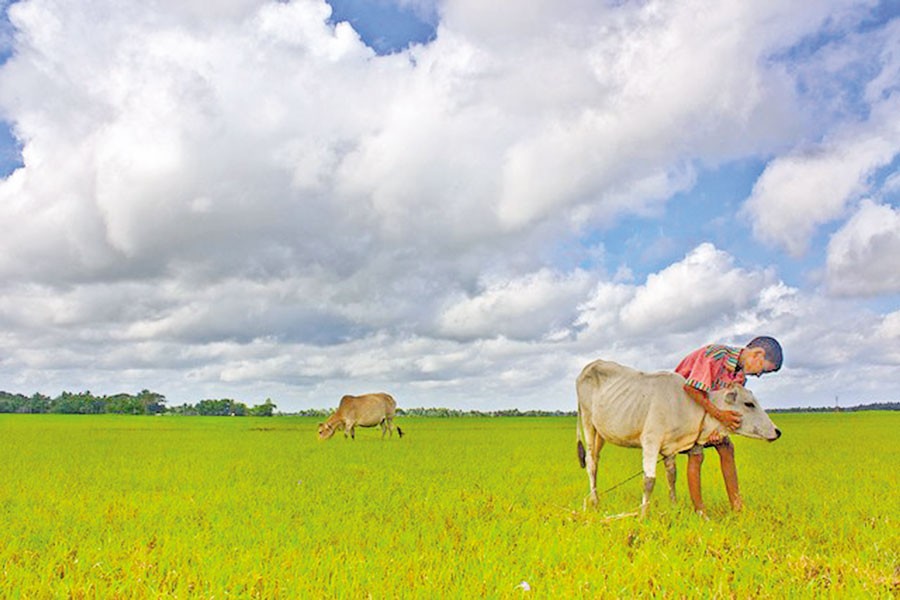
Published :
Updated :

Hemanta has at last returned at its mystical ---and perhaps magical --- best. Yes, for many years, maybe decades, the six seasons in this part of the world have gone berserk either losing their distinctive sights, sounds and colours or overlapping one another. But this time the duskiness, dews and mist that hangs on the horizon like a gloomy ring of Jibananda's favourite season is amply manifest. This uniqueness is definitely the discovery by the poet of the deltaic basin known as Bangla when it was undivided.
Perhaps in no place on this planet, there is such a gloomy and yet enchanting season. One does not have to be a poet to see the change in Nature, feel the pall of brooding gloom that spreads like a pensive mind's expanse. No it is not impervious or foreboding but there is a kind of pining for it one feels in one's heart. It is inexplicable and yet unavoidable. The attraction is there but still the charm is not vivid rather subdued that leads one to explore deeper and deeper.
Like the pathos of raga malkauns, there is something sad in the air but it is not as sharp as that of Autumn when amid the bright sun shine and clear blue sky, a sharp note of melancholy runs through the void. Both seasons stand apart to give one a sense of aloofness if not loneliness but the difference between them is the overtone of something like mysticism in Hemanta which is not the case in Autumn.
Hemanta is a harbinger of Winter. While for many years winter had been a near absentee landlord of this land, Hemanta also gave an impression of an amorphous, undefined and illegitimate product of Nature. This time the mild and pleasant chill is already there and the morning sun warms the heart.
Whether it is the influence of a half-formed cyclonic storm named Sitrang or, as the climatologists claim, a stratospheric cooling event that is occurring over the Southern Hemisphere 'following a massive injection of water vapour', the fact is Hemanta has got its unique characteristics back prompting the Winter to follow in its footsteps.
People who care to look for the varying charms of Nature all around will be pleased to see that the Hemanta Jibananda discovered in its myriad enchanting ways is back. Certainly, this concrete jungle of Dhaka is not an ideal place for rediscovering the small delights each season presents like gifts from heaven. There are hardly occasions to watch when a kite of golden wings is on a flight into the glows of the setting sun. Or, a shepherd leads his herd of cattle through the dim mist in the distant horizon like a caravan.
For those who are not particularly fond of the world all around, there could be one particularly unavoidable allurement in the shape of Nabanna. It is the festival of harvest. New crop, paddy to be precise, is harvested and the occasion is celebrated on the first day of Agrahayan on the Bangla calendar. On this occasion, food--- mainly cakes--- prepared from newly harvested rice is prepared and in accompaniment with dance and music the occasion is celebrated. It is part of a folk culture that is on the way of disappearing fast.
In fact, in many areas of Bangladesh today, Aman paddy is no longer cultivated and the question of harvesting paddy at this time does not arise. High-yielding paddies are cultivate in the month of Poush and Magh, which are cultivated in Chaitra and Baishakh ---the time when Aman paddy was sown in the past.
So, the scenic change in the rural setting in wider swathes of Bangladesh is remarkably anti-Hemanta. At least in those areas where Aman cultivation is no longer the practice, the way of rural life and livelihoods have undergone radical changes. Rediscovering Hemanta will mostly be a futile search there. But in areas where Aman is still cultivated and harvested, the season is sure to appear in its original shape.
One only hopes that the farming community also keeps the rural tradition of Nabanna alive there. In the city, the occasion is celebrated courtesy of cultural institutions through neatly arranged programmes but too much neatness is no plus point for the rustic and spontaneous exuberation of life. Hemanta is no time for celebrating colours in their rioting splendour and gorgeousness but it becomes compatible if celebrated in mellifluous and mystical self-effacing manner. A tribute of this order is what it deserves.


 For all latest news, follow The Financial Express Google News channel.
For all latest news, follow The Financial Express Google News channel.